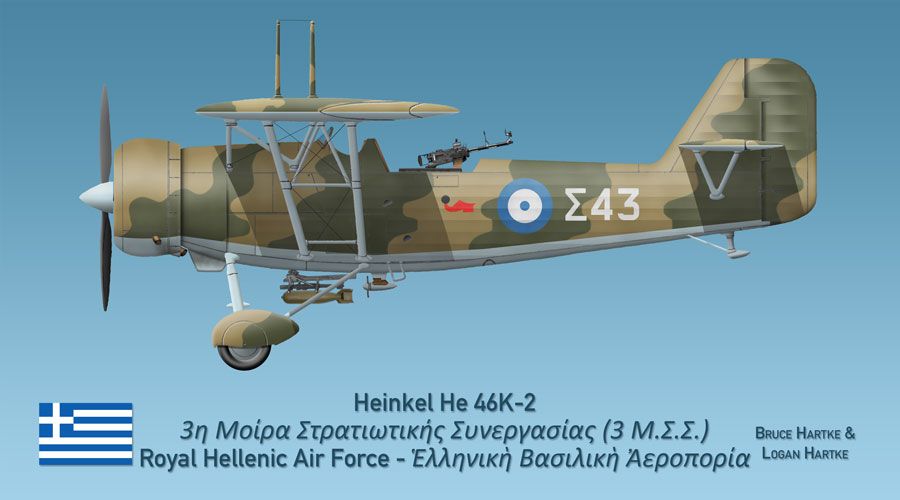Just finished this one tonight. This one was actually pretty involved. Custom camouflage, custom roundel, custom numbering, custom Browning FN machine gun, custom bomb rack, custom "American-type" bomb, and custom "Tsarouhi" marking on the side of the aircraft. All were made just for this profile. Nothing was an easy drag and drop on this profile, but I REALLY like the way it all came together.

The acquisition of Heinkel He 46s to augment and replace the obsolete Potez 25 A.2s and Breguet 19 A.2/B.2s was apparently initiated in spring 1935. The Heinkel Flugzeugwerke A.G. was advised by the Reichsverband der Deutschen Luftfahrt-Industrie (RDLI) in July 1935 that the Greek air force was interested in their "multi-role aircraft", whereupon Heinkel made preparations to meet an order for 16 to 32 He 46s. Greek officers visited the Heinkel factory in Rostock-Marienehe in November 1935, and one of them flew an He 46.
The contract finally signed on 18 April 1936, covered the purchase, for approximately three million Reichsmark, of 16 export versions of the Heinkel He 46 (type K) with five spare engines, maintenance equipment and 16 additional bomb racks. In the end, the latter were never delivered and Greece was forced to develop their own solution. The aircraft were also provided with luxurious editions of German maintenance manuals translated into Greek. The contract made provision for possible follow-up sales and license manufacturing parts and materials. The contract did not cover the mounting for the observer's gun on each He 46 or various other items of equipment, which surely included the choice of the type of machine gun the acquisition of these being left to the purchaser. A Greek acceptance commission started work at Rostock-Marienehe in June 1936, Athens having meanwhile expressed a wish to purchase further aircraft. Construction of the 16 export version He 46Ks was completed by September 1936, and Greek ferry pilots arrived in late November for delivery by air to Tatoi aerodrome at Athens.
The suffix "K" (Kampf, i.e. combat) appended to the designation of the He 46s delivered to Greece, also indicates they were neither standard He 46E-1s nor He 46G-ls, that some items of equipment were not identical with those fitted on the Luftwaffe versions and/or that modifications had been specified by the Royal Hellenic Air Force (RHAF). It was powered by the BMW 132 and the radio equipment was downgraded compared with that used by the Luftwaffe. The armament comprised a 7.92 mm FN Browning on a flexible mounting for the observer. Locally manufactured "American-type" 50 kg and 14 kg bombs were carried on racks of RHAF design fitted under the fuselage just behind the landing gear, under the pilot's cockpit and in the bay behind the observer's cockpit.
On 28 October 1940 at 5.30am, Italian troops based in Albania attacked Greece. The Heinkels were entered service with the 3rd Army Cooperation Squadron and were ready for action. The first aircraft lost by the Greek Air Force during the Italian invasion was a He 46. Apart from extensive reconnaissance, the Greek He 46s were often used successfully against enemy troops and ground targets. One of the successful and unusual actions was flown on 21 November 1940, when three He 46s of the 3rd Squadron scattered a 6 km long column of Italian troops at Pogradec in just one attack.
Early on April 6, 1941, Hitler launched the assault on Greece and Yugoslavia, Operation Marita, to rescue the Italian army in retreat in Albania and to prevent British forces from establishing bases in Greece from which bombers could raid the oil fields in Romania vital to the German war effort. Third squadron with its Heinkels was based at Agrinion in western Greece when, on April 22, the airfield was strafed by Messerschmitt Bf 109s with devastating effect, five of the Do 22Kgs and all but one Heinkel being destroyed. Later in the day the last serviceable Heinkel, was flown to Argos in the Peloponnese to join the surviving Potez 25s, PZL P.24s and some other aircraft, as well as RAF Hurricanes. On April 23 Argos was successively attacked by Dornier Do 17Zs, Junkers Ju 88s, Bf 109s and finally almost all the Greek aircraft had been destroyed. The German forces advancing into Greece in April 1941 found a damaged Heinkel He 46 coded Σ (Sigma) 43 on an abandoned Greek airfield. Obviously this or any other Greek Heinkel was never used by the Luftwaffe.
Cheers,
Logan